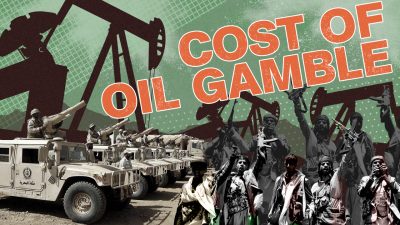Video: Impressive Successes of Houthis in Yemeni War Amid Saudi Oil Gamble

The conflict in Yemen has escalated amid the crisis on the oil market caused by aggressive actions of Saudi Arabia.
On March 8, Riyadh launched its oil gamble flooding the market and offering unprecedented discounts in an attempt to defeat other oil producers, mainly Russia and Iran, and capture their share. In the next several weeks, Saudi Arabia was increasing its pressure on Russia on Iran slashing oil prices, but the Kingdom forgot about its own soft underbelly.
By March 17, forces of Ansar Allah (the Houthis) have captured most of the province of al-Jawf, including the provincial capital – al-Hazm, from the Saudi-led coalition and its Yemeni proxies. In this battle only, Saudi-led forces lost hundreds pieces of military equipment, including dozens of battle tanks and artillery guns. The Saudi Air Force carried out airstrikes on positions, HQs and weapon depots of its allies. However, the number of abandoned equipment and the speed of fleeing of Saudi-backed troops were so high that 10-20 airstrikes were just not enough to compensate them.
Following the swift advance in al-Jawf, Asnar Allah turned its attention to the neighboring province of Marib. They captured a number of Saudi positions east of Sirwah, including the Kufil military base, a key stronghold of Saudi-backed forces on the route to Marib city. After this, the defense of Saudi proxies started collapsing in the entire eastern part of the province. If the situation develops in the same direction and further, Yemeni forces will likely be able to reach and besiege Marib city in early April and capture it by the middle of the month.
Meanwhile, Ansar Allah units forces pro-Saudi forces from the key district of Nihm near the country’s capital Sanaa. The district had been contested since early 2020. Nonetheless, now, it’s
Pro-Saudi sources regularly claim that Ansar Allah suffers large-scale casualties, but often fail to provide any visual evidence to confirm these claims. In own turn, most of the recent successes of Ansar Allah were carefully documented by their media branch.
The Saudi-led coalition also faced a never-before-seen resistance to its air power. In January and February, Ansar Allah shot down several unmanned aerial vehicles of the coalition. In March, its forces moved to direct attacks on coalition warplanes. On March 14, Yemeni air defense forces launched missiles at a group of F-15 and F-16 jets over the province of al-Jawf. On March 19, several missiles were launched at coalition warplanes over the district of Sirwah in the province. In both cases, Ansar Allah employed the so-called Fatir-1 air defense system. This is a locally-modernized variant of the Soviet-era 2K12 Kub system. The Fatir-1 was revealed in August of 2019. The claimed effective range of the system is 22 km.
Fatir-1 launched did not result in downing of any coalition jets, but the existence of the new threat itself limited operations of the Saudi air power.
In March, the main area of clashes between Ansar Allah and Saudi forces was northeastern and central Yemen. However, if the oil price will remain under the level of 35 USD per a barrel, a new round of Ansar Allah offensive will take place inside Saudi Arabia.
*
Note to readers: please click the share buttons above or below. Forward this article to your email lists. Crosspost on your blog site, internet forums. etc.
Support South Front in its endeavors. If you’re able, and if you like our content and approach, please support the project. Our work wouldn’t be possible without your help: PayPal: [email protected] or via: http://southfront.org/donate/ or via: https://www.patreon.com/southfront

